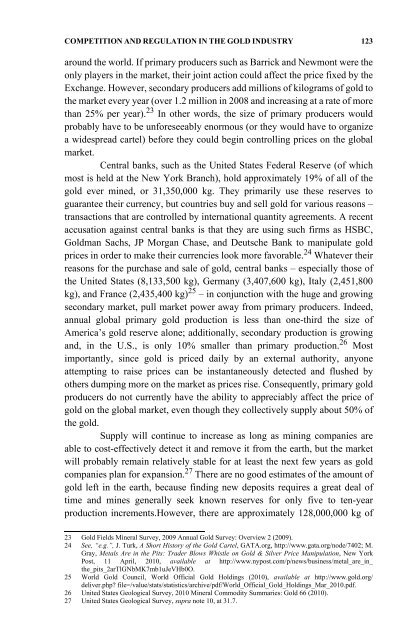University of Botswana Law Journal - PULP
University of Botswana Law Journal - PULP
University of Botswana Law Journal - PULP
Create successful ePaper yourself
Turn your PDF publications into a flip-book with our unique Google optimized e-Paper software.
COMPETITION AND REGULATION IN THE GOLD INDUSTRY 123<br />
around the world. If primary producers such as Barrick and Newmont were the<br />
only players in the market, their joint action could affect the price fixed by the<br />
Exchange. However, secondary producers add millions <strong>of</strong> kilograms <strong>of</strong> gold to<br />
the market every year (over 1.2 million in 2008 and increasing at a rate <strong>of</strong> more<br />
than 25% per year). 23 In other words, the size <strong>of</strong> primary producers would<br />
probably have to be unforeseeably enormous (or they would have to organize<br />
a widespread cartel) before they could begin controlling prices on the global<br />
market.<br />
Central banks, such as the United States Federal Reserve (<strong>of</strong> which<br />
most is held at the New York Branch), hold approximately 19% <strong>of</strong> all <strong>of</strong> the<br />
gold ever mined, or 31,350,000 kg. They primarily use these reserves to<br />
guarantee their currency, but countries buy and sell gold for various reasons –<br />
transactions that are controlled by international quantity agreements. A recent<br />
accusation against central banks is that they are using such firms as HSBC,<br />
Goldman Sachs, JP Morgan Chase, and Deutsche Bank to manipulate gold<br />
prices in order to make their currencies look more favorable. 24 Whatever their<br />
reasons for the purchase and sale <strong>of</strong> gold, central banks – especially those <strong>of</strong><br />
the United States (8,133,500 kg), Germany (3,407,600 kg), Italy (2,451,800<br />
kg), and France (2,435,400 kg) 25 – in conjunction with the huge and growing<br />
secondary market, pull market power away from primary producers. Indeed,<br />
annual global primary gold production is less than one-third the size <strong>of</strong><br />
America’s gold reserve alone; additionally, secondary production is growing<br />
and, in the U.S., is only 10% smaller than primary production. 26 Most<br />
importantly, since gold is priced daily by an external authority, anyone<br />
attempting to raise prices can be instantaneously detected and flushed by<br />
others dumping more on the market as prices rise. Consequently, primary gold<br />
producers do not currently have the ability to appreciably affect the price <strong>of</strong><br />
gold on the global market, even though they collectively supply about 50% <strong>of</strong><br />
the gold.<br />
Supply will continue to increase as long as mining companies are<br />
able to cost-effectively detect it and remove it from the earth, but the market<br />
will probably remain relatively stable for at least the next few years as gold<br />
companies plan for expansion. 27 There are no good estimates <strong>of</strong> the amount <strong>of</strong><br />
gold left in the earth, because finding new deposits requires a great deal <strong>of</strong><br />
time and mines generally seek known reserves for only five to ten-year<br />
production increments.However, there are approximately 128,000,000 kg <strong>of</strong><br />
23 Gold Fields Mineral Survey, 2009 Annual Gold Survey: Overview 2 (2009).<br />
24 See, “e.g.”, J. Turk, A Short History <strong>of</strong> the Gold Cartel, GATA.org, http://www.gata.org/node/7402; M.<br />
Gray, Metals Are in the Pits: Trader Blows Whistle on Gold & Silver Price Manipulation, New York<br />
Post, 11 April, 2010, available at http://www.nypost.com/p/news/business/metal_are_in_<br />
the_pits_2arTlGNbMK7mb1uJeVHb0O.<br />
25 World Gold Council, World Official Gold Holdings (2010), available at http://www.gold.org/<br />
deliver.php? file=/value/stats/statistics/archive/pdf/World_Official_Gold_Holdings_Mar_2010.pdf.<br />
26 United States Geological Survey, 2010 Mineral Commodity Summaries: Gold 66 (2010).<br />
27 United States Geological Survey, supra note 10, at 31.7.
















